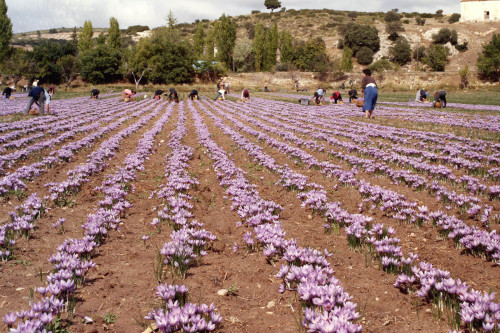Saffron Strands non organic, 0.5g, Steenbergs MINI JAR details and description
Saffron is one of the most expensive of spices by weight due to the fact that the stamens of the crocus are picked by hand. It is hugely labour intensive. Steenbergs saffron comes from a family run farm in Spain. It is a truly excellent saffron. There's so many things to do with just a few strands of saffron from adding it to rice, to paella - whatever you do with it, it's always an enriching and luxurious meal. For example, why not try paella from Steenbergs' Recipe Pages or a luxurious saffron tea.
Saffron comes from an ornamental, autumn-flowering perennial crocus which only grows to about 15cm (6 inches) tall. Saffron, Crocus sativus, grows from corms (bulbs) which resemble small onions in appearance, which then send up long, gray-green chive-like leaves. On another stem, saffron crocuses grow lily-like, blue to violet flowers with vividly contrasting, bright-orange stigmas and fluffy yellow, pollen-bearing stamens. Each saffron flower has three stigmas connected to the base of the bloom by a fine, pale thread, the style. It is the stigmas that make saffron spice, which when dried and separated from the style range from 10-18mm long (0.33-0.67 inches), and are a dark-red and thin fibre, that start thin and then fan out a little at the tip in a buisine (straight old-fashioned trumpet) shape. The aroma of saffron is woody, sweet and strongly floral while the flavour is bitter, lingering and appetising. Its pungency comes from safranal and the earthy, bittersweet flavour from picrocrocin. But it is its colour that is its defining feature which comes from the powerful, soluble dye, crocin, which is in the blood-red stigmas' colour. When released, saffron dyes food to a charming and magical orange-yellow that adds so much light coloured foods such as rice. As for the cost, this arises because of the method of processing, which is intensely hand-driven - for a period of three weeks, nearly every inhabitant of a town, including all generations, must work on collecting the valuable saffron stigmas. Each plant produces up to three flowers on consecutive mornings and through back-breaking work, the blooms must be collected before the sun gets too hot, then the precious stigmas are removed by the womenfolk, who work through the night to keep up with the supply of gorgeous blue flowers coming in from the fields. At this stage, the stigmas have no flavour (like many spices have before further curing and processing), so the spice is cured by reducing the moisture content to 12% by some form of artificial heat. Therefore, 1kg of saffron comes from 8.25kg of fresh stigmas and consists of roughly 300,000 crocus flowers* picked and 370-470 hours of work, so one pot of 0.5g comes from about 150 bulbs or 30 minutes of time, so based on a UK minimum wage would be roughly £3 in time costs or £5 based on UK average wages! now that is dedication or really hard work, depending on your point of view. For some photos of saffron picking and processing, visit Steenbergs' Facebook site. For more on saffron, read Gernot Katzer's Spice Pages and Wikipedia.
Saffron is usually used for its colour, for example 10 stigmas will colour 3 tablespoons (30ml) of warm water or rosewater in about 20 minutes, which can then be used later. Traditionally, saffron is used in colouring Spanish paella, Italian risotto and Indian rice dishes, as well as making saffron cake, while we use it in making Steenbergs Ras Al-hanut. Why not add a little to potatoes to create a really luxurious twist to an everday staple? For more on ideas for saffron, try Steenbergs' recipes pages or the BBC website.
A quick word on qualities: the best saffron is deep red and called coupe for Kashmiri and Spanish saffron and sargol for Iranian saffron. In the next grade there is a proportion of thicker yellow threads for mancha from Kashmir or Spain and kayam from Iran; basically it is mostly the three stigmas still as plucked from the bulb rather than having had the yellow base cut off, adding even more embedded labour hours. Some good quality saffron also comes from Greece and Italy. Lesser grades are brownish colour and stubby, while too much yellow means it is either lesser quality or you are being sold something else, e.g. safflower!
Steenbergs saffron forms an important part of our huge range of specialist ingredients, ranging from organic herbs and organic spices, plus organic blends, organic extracts and flower waters, organic stuffings and organic teas and hot chocolates and all things nice and a few rather hot and spicy. For more information on Steenbergs kit, browse the website, phone us for a chat on 01765 640 088 as we like a natter or email to enquiries@steenbergs.co.uk.
* Various writers say around 32,000 crocus flowers per 1kg of saffron, but I have counted 1g and it is 900 filaments or 300 bulbs per kg, which grosses up to 300,000 per kilo. So I reckon people are out by a factor of 10!









